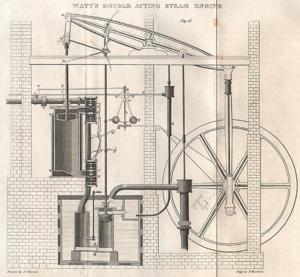
invented in 1782 by James Watt
The overall arrangement of the engine is similar to the single acting engine, but steam enters the cylinder from both sides, at the bottom when the piston is in its down position and at the top when it is up. Two corresponding connections to the condenser allow the piston to be exposed to the vacuum effect in both directions.
The illustration shows other improvements. On the right is a system to convert up-and-down motion into circular motion. It includes a flywheel to give more even action. The governor (two balls hanging from rods in the centre) rotates and controls the engine speed: When the engine speeds up the balls are lifted by the centrifugal force, which activates a throttle on the steam supply and slows the engin down.

Lardner, D. (1852) The Steam Engine Familiarly Explained and Illustrated. A. Hart, Philadelphia.
from http://ww